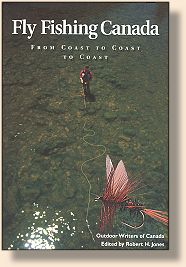Fly-Ins, Part 4
By Dr.Martin Lamont
From Fly Fishing Canada From Coast to Coast, Published
by Johnson Gorman Publishers. We appreciate use permission.
The Northwest - Yukon Klondike Charters
Like it's people, there is a youthfulness in this
northern land, which has more square miles per angler
than the rest of Canada. Travelers are tempted by
excellent fly-fishing opportunities for lake trout,
pike, grayling, Dolly Varden and white fish - including
inconnu. Transected by the Alaska Highway and only a
few side roads, fly-ins are essential. Whitehorse has
waterftont floatplane facilities on the Yukon River.
Many fishing destinations are within 50-200 air miles
(80 - 320 km), so it is only a few hours' flying time
to various full-service lodges and wilderness camps.
The bright yellow Super Cub made a long approach, then
descended onto the remote Yukon lake and touched down
smoothly. After we disembarked near the lake's outlet,
I quickly decided to split from the group as they paddled
in their float tubes across the flat, calm lake. Exploring
the outlet river was made easy by its low water, and
the large boulders were great for walking on. The first
few pools were crystal clear, and fish shadows were
visible in the depths. Looking closer, I identified
them as Dolly Varden.
It was frustrating as fish after fish followed my flies
out of the depths, almost into the shallows at my
feet, but refused to take. I accidentally hooked a small
fingerling, and when it started darting about, it was
instantly consumed by a 5-lb (2-kg) Dolly which set my
rod to bucking and throbbing. When I finally brought
it into the shallows, I discovered the Dolly was not
hooked, merely clamped tight onto the now dead and
badly mutilated fingerling. The almost grounded Dolly
eventually opened its mouth, and slowly departed for
deeper water. Clearly, Dollies prefer meat to feathers.
Farther downstream, where feeder creeks were slightly
coloring the main stem, I found a midstream school of
feeding grayling. They were holding in fast water and
constantly rising to small blue-gray Ephemeroptera.
They were very selective and required constant changes
of flies. A small Gray Wulff worked for a few fish,
then a Gray Hendrickson started more hook-ups. I
realized that as the grayling became familiar with
one pattern, a change provoked more strikes.
The next half mile of the river was white water. There
I dredged the deeper pockets with a big, ugly,
ultra-fast-sinking black Hellgrammite pattern to
take grayling to 3 lb (1.5 kg). Below that section,
the river again formed deep, isolated pools, and the
rock formation changed to brown, broken sandstone.
Fishing with Glo-Bugs, Mickey Finns and Sculpin
patterns constantly produced smaller, darker Dollies
with bright scarlet spots, strangely different from
those caught in the outlet's clear water.

My return to the lake revealed that my companions had
found good fun in the shallow bays catching pike on
streamer flies. The aroma of filleted and cubed
"Yukon gold pike" sizzling in the frying pan was a
harbinger of one of the finest of wilderness meals.
Alberta
Alberta's fly-out centers are widely separated. The
southwest Rocky Mountain area is served by Calgary and
Canmore which, being major tourist centers, have aircraft
for heli-hiking and fishing in the high mountains readily
available. To the northeast of the province, in the
boreal forests and to some extent in the northwest
Caribou Mountains, are about 10 fly-in lodges with
fishing for lake trout, pike, walleye and whitefish.
Some are the original full-service fishing lodges
like Andrew Lake and Christina Lake, while others
are tent camps. Northern Alberta fly-in operators
use Edmonton, Cold Lake and Fort McMurray as home
bases.
Continued Next Time
Credits: Excerpt from Fly Fishing
Canada written by Outdoor Writers of Canada,
edited by Robert H. Jones, Published by Johnson
Gorman Publishers. Used with permission.
Our Man In Canada Archives
|

